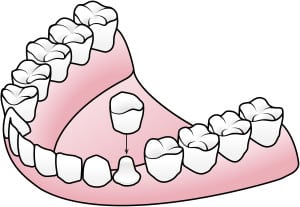 Although placing a dental crown is more invasive than an inlay or an onlay, it is not a very complex procedure. It takes two visits, but only because the crown is fabricated outside the office in a dental lab. During the first visit your dentist prepares the tooth, during the second visit he or she places the crown. You may know someone who has received a dental crown, or your dentist may have suggested that you need crown treatment, so today we explain how a crown is placed.
Although placing a dental crown is more invasive than an inlay or an onlay, it is not a very complex procedure. It takes two visits, but only because the crown is fabricated outside the office in a dental lab. During the first visit your dentist prepares the tooth, during the second visit he or she places the crown. You may know someone who has received a dental crown, or your dentist may have suggested that you need crown treatment, so today we explain how a crown is placed.
Crown Treatment
Crown treatment is used to restore a tooth that is too damaged for a filling, but has enough healthy tooth structure left to save. In such cases your dentist will remove the damage or decay and “cap” the original tooth with a dental crown. The crown restores your chewing function, the shape and size of your tooth, and will blend with the surrounding dentition.
Crown Placement
Placing a crown is a minimally invasive procedure. It will require your dentist to numb the area that he or she will be working on before preparing the damaged tooth for the new crown. Once the tooth is prepared and shaped to accommodate the new tooth, by removing the damage or decay, an impression is taken using dental putty. The impression is sent to the dental lab and used to shape the new crown for a precise fit. At this point a temporary crown is placed.
Visit #2
During the second visit the temporary crown is removed and the remaining tooth structure cleaned and disinfected. The new permanent crown is assessed for fit, comfort, size, and color. If everything is correct your dentist will permanently cement the crown over the remaining prepared tooth structure, and your tooth is restored.
